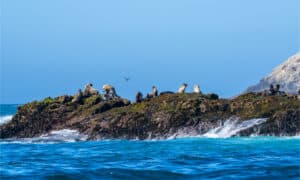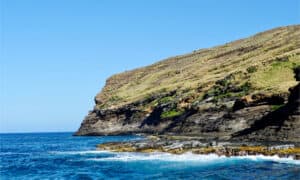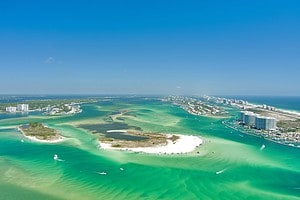The Atlantic Ocean is the world’s second-largest ocean covering about 20% of Earth’s surface and 29% of its water surface with an area of about 41,100,000 square miles. There are bound to be a few land masses found throughout it. The Atlantic Ocean is home to more than 50 islands, some making up what is called an archipelago which is a chain or group of islands. Many of the islands discovered were either once or still are inhabited by humans. Let’s go over some of the Islands in the middle of the Atlantic Ocean and the history and life that they hold.
Islands can be formed by a variety of processes, including sediment deposition, glacial retreat, and when continental plates collide. These small or large masses of land can have very different biomes depending on their location. Due to human colonization of islands throughout the Atlantic, vegetation and animal life has been altered on many of the islands. Each island is different and interesting in its own way. Let’s take a look at some of the islands in the middle of the Atlantic.
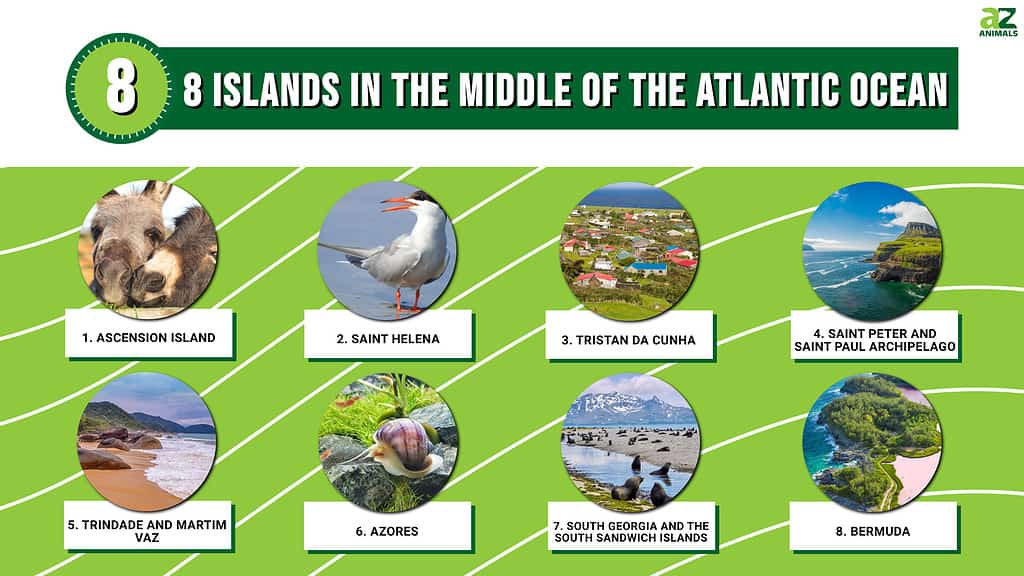
1. Ascension Island
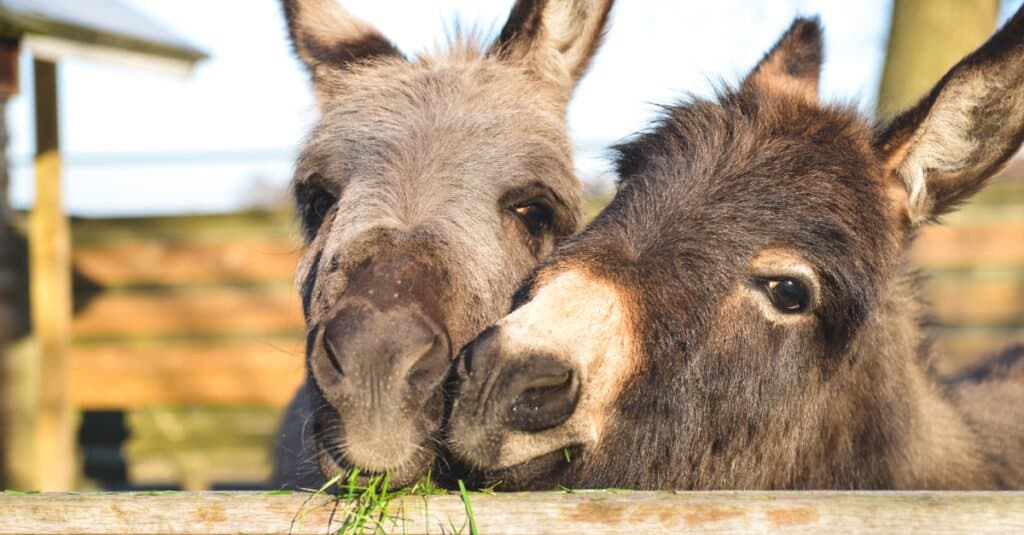
Animals like donkeys, cats, and sheep have been introduced to Ascension Island over the years.
©babeaudufraing/Shutterstock.com
| Ascension Island | ||
|---|---|---|
| Area (square miles) | Location | Population |
| 34 | UK | 800 |
Located about 1,400 miles from the coast of Brazil in the South Atlantic Ocean is an isolated volcanic island called Ascension Island. This island was discovered in 1501 by João da Nova on what’s known as “Ascension Day,” which is what brought about the name. After its discovery, it was mainly used by passing ships to collect the meat. They did this by hunting seabirds and giant female green turtles that used the island to lay their eggs.
Ascension Island is now used for many different purposes. Currently, the island is home to the UK’s Royal Air Force Station, the BBC World Service Atlantic Relay Station, an Anglo-American signals intelligence facility, and European Space Agency rocket tracking station. The island is also home to one of four ground antennas that assist in the operation of the Global Positioning System.
The island has had many different animals introduced over the years, like donkeys, cats, rats, sheep, and goats. Some native land animals include the land crab, green turtles, and the Ascension frigate bird. In 2016 the UK government announced Ascension Island would become a huge marine reserve to protect its unique ecosystem.
2. Saint Helena

Sea birds are among the most abundant animals on Saint Helena Island, using the area as a breeding ground.
©iStock.com/YanLev
| Saint Helena | ||
|---|---|---|
| Area (square miles) | Location | Population |
| 47 | UK | 4,439 |
Saint Helena is a remote volcanic island about 1,200 miles west of the southwest African coast. This island is best known for being the island Napoleon Buonaparte was exiled to after his final defeat in the Battle of Waterloo. Considered one of the remote islands in the world, Saint Helena was discovered in 1502 by João da Nova. It’s the United Kingdom’s second-oldest overseas territory.
When discovered, Saint Helena Island was abundant in fresh water and trees and various flora and fauna like the red crab. St. Helena is home to around 200 species of birds and has been identified as an important area for bird conservation by Birdlife International. Due to deforestation on the island, many species that once lived here have become extinct, like the endemic Saint Helena Hoopoe. Reforestation for a section on the northeast corner of the island started in 2000 to try to restore the trees that once stood before the island’s colonization.
3. Tristan da Cunha

Tristan da Cunha is located 1,732 miles off the coast of Cape Town, South
Africa
.
©maloff/Shutterstock.com
| Tristan da Cunha Islands | ||
|---|---|---|
| Area (square miles) | Location | Population |
| 80 | UK | 245 |
Tristan da Cunha is located 1,732 miles off the coast of Cape Town, South Africa. These volcanic islands are one of the most remote inhabited islands in the world. The archipelago consists of Tristan da Cunha, Gough Island, Inaccessible Island, and a group of small islands called the Nightingale Islands. Currently, Tristan da Cunha is inhabited, Gough Island and Inaccessible Island are wildlife reserves, and the Nightingale islands are uninhabited.
These islands are home to many animals and plants. The islands are the breeding ground for 13 different species of seabird, and the Tristan albatross, spectacled petrel, and the Atlantic petrel are known to only breed here. This has made the area an important area for bird conservation, according to BirdLife International.
Invasive house mice have become a problem on these islands. The group of islands is not equipped to deal with invasive flora and fauna. The mice are thought to have been introduced by seal hunters in the 19th century. The mice have grown to be 50% larger than average house mice.
4. Saint Peter and Saint Paul Archipelago

Fifteen small islands make up what is known as Saint Peter and Saint Paul Archipelago.
©Dmitry Pistrov/Shutterstock.com
| Saint Peter and Saint Paul Archipelago | ||
|---|---|---|
| Area (square miles) | Location | Population |
| 0.057 | Brazil | 4 |
Saint Peter and Saint Paul Archipelago is a group of 15 small islets and rocks that are about 620 miles from the north-eastern coast of Brazil. These small islands are not volcanic but made due to geological uplift. They are the only location where the abyssal mantle is exposed above sea level. In 1832, Charles Darwin visited the island and recorded the flora and fauna he found, which were two birds, a large crab, and a few bugs.
The islands were discovered in 1511 by the Portuguese Navy on the Saint Peter caravel. Saint Peter crashed into the islands, and the fleet was rescued by the Saint Paul caravel, which is how the islands got their name. The Islands were named an environmentally protected area that is now part of the Fernando de Noronha Environmental Protection Area. In 1998, the Brazilian Navy took up residence and has since remained.
5. Trindade and Martim Vaz
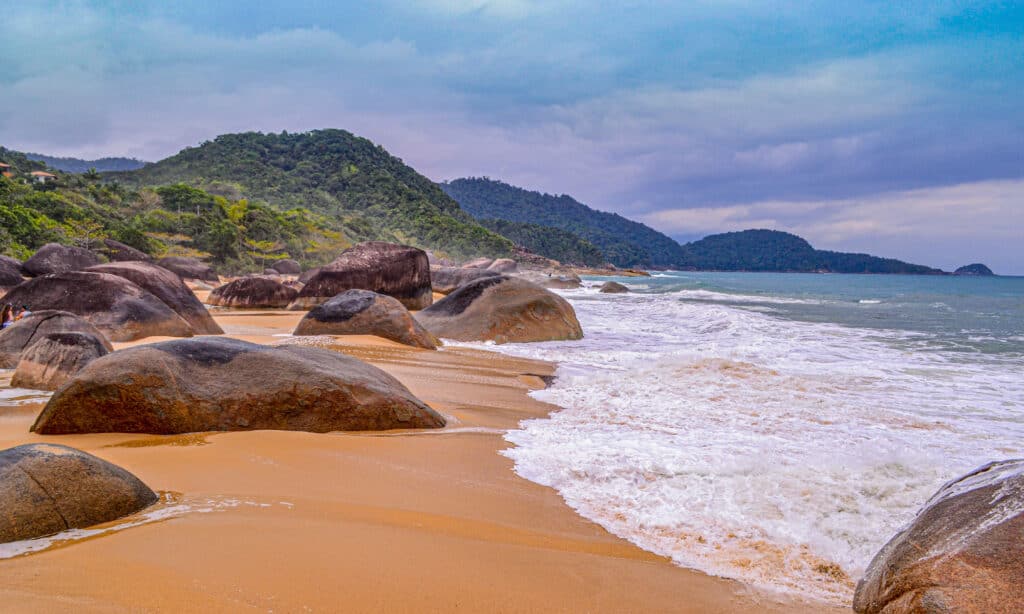
Trindade and Martim Vaz is currently the largest nesting area in Brazil for the green
sea turtle
.
©iStock.com/Catherine Scotton
| Trindade and Martim Vaz | ||
|---|---|---|
| Area (square miles) | Location | Population |
| 4 | Brazil | 8 |
The Trindade and Martim Vaz island is a group of six small land masses located near the middle of the Atlantic Ocean. They are 680 miles east of the coast of Espírito Santo. These islands are mostly barren, and due to the introduction of invasive species like sheep, goats, and pigs, the biodiversity has heavily declined. Many indigenous species have become endangered since the 1950s.
The islands were discovered in 1502 by Portuguese navigators. When the island was first discovered, it was covered in a forest of Colubrina glandulosa trees. After the introduction of invasive species, the same trees became locally extinct and has led to multiple springs on the island drying up.
Trindade and Martim Vaz is currently the largest nesting area in Brazil for the green sea turtle. They are also the breeding grounds for many sea birds, including the endemic great frigatebird. Humpback whales have also been using Trindade Island as a nursery for their young.
6. Azores
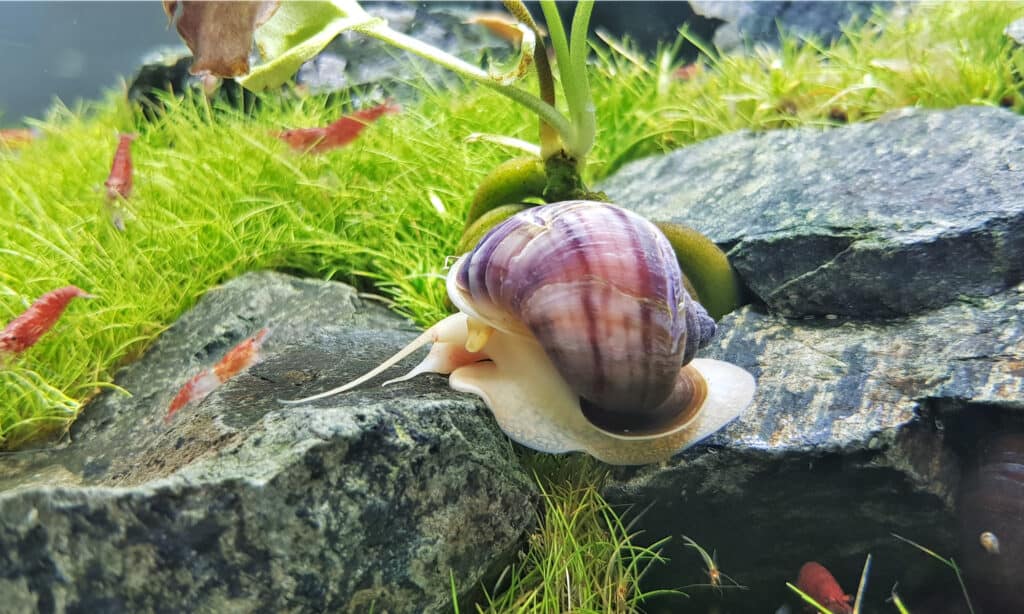
In 2013, around 30 new species of snail were discovered on the Azores Islands.
©Arunee Rodloy/Shutterstock.com
| Azores Islands | ||
|---|---|---|
| Area (square miles) | Location | Population |
| 908 | Portugal | 236,440 |
Found about 930 miles northwest of the coast of Morocco is a group of nine islands called the Azores near the middle of the Atlantic Ocean. These nine volcanic islands are named Corvo, Flores, Faial, Pico, Graciosa, São Jorge, Terceira, São Miguel, and Santa Maria. The majority of the island is covered in laurel forests, cypress forests, and small areas of agricultural land and populated centers.
Many of the island’s plants and animals are endemic. 411 species out of 6,000 are endemic to the islands. Most of the endemic animals are arthropods and mollusks. New animals are regularly discovered on the island.
Some animals endemic to the islands are The Azores bullfinch and the Monteiro’s storm petrel, which are birds, and Azores noctule, which is a bat. Islets around the Azores have areas, like the Dollabarat Reef, rich in marine life. Here you can find a variety of animals like sharks, manta rays, whales, and sea turtles.
Due to colonization, a large portion of the vegetation has been wiped out in the past six hundred years for things like houses, boats, firewood, and tools. Because of this, almost half of the insects on Graciosa have been wiped out or will soon become extinct. Some abandoned agricultural areas have become overrun by invasive plant species such as hydrangeas. Invasive species can be an issue for islands like the Azores because of the inability to regrow native plant species if overrun by invasive ones.
7. South Georgia and the South Sandwich Islands
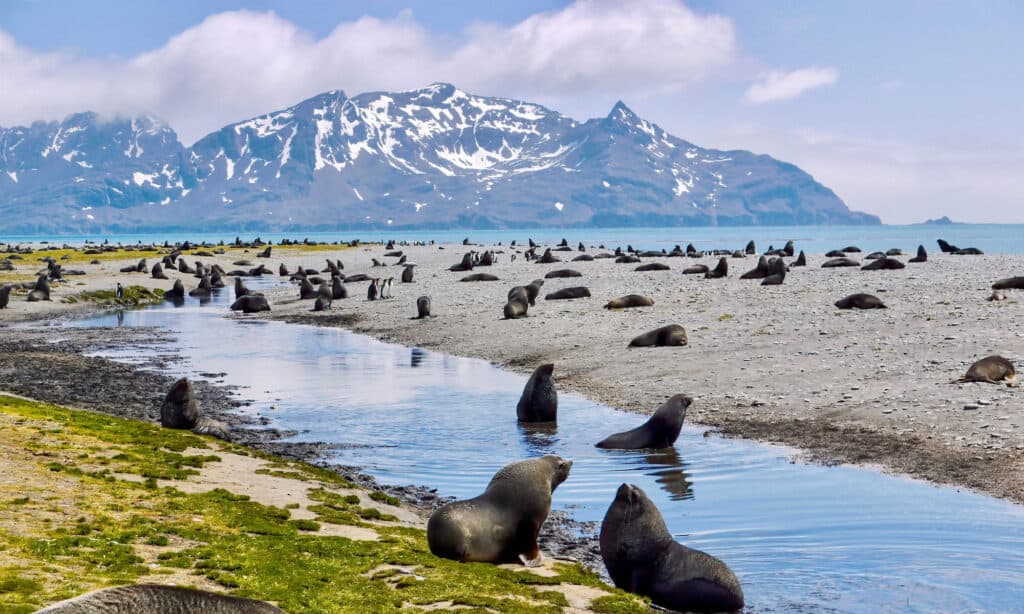
South Georgia is home to different animals and endemic species.
©iStock.com/Cheryl Ramalho
| South Georgia and the South Sandwich Islands | ||
|---|---|---|
| Area (square miles) | Location | Population |
| 1,507 | UK | 30 |
Some of the islands you can find in the middle of the Atlantic Ocean are South Georgia and the South Sandwich Islands. South Georgia and the South Sandwich Islands are 12 islands. South Georgia is the main island, and by far the largest, and the South Sandwich Islands is a group of 11 small islands located southeast of South Georgia. The islands are named in honor of King George III of the United Kingdom and John Montagu, 4th Earl of Sandwich.
The climate on these islands is classified as polar, making the islands a tundra. The temperature varies on each island but is typically between 8 °C (46.4 °F) and −10 °C (14 °F) depending on the season. Due to the cold temperatures, most of the islands are covered in permanent layers of ice or snow. The areas of the islands that aren’t covered in snow or ice have few native species of plants and some introduced invasive species of plants.
South Georgia is home to different animals like king penguins, Macaroni penguins, prions, shags, skuas, and endemic species like the South Georgia shag, South Georgia pipit, and the South Georgia pintail. There are no native mammals on the islands. Some animals like reindeer and brown rats have been introduced.
8. Bermuda

Altogether, there are around 181 different islands that make up Bermuda.
©iStock.com/Ashley Hense
| Bermuda Islands | ||
|---|---|---|
| Area (square miles) | Location | Population |
| 20.5 | UK | 63,913 |
Connected by bridges, Bermuda is a group of 181 islands though they look as if they’re one. Spanish explorer Juan de Bermúdez discovered the islands in 1505. When the islands were discovered, they were uninhabited by humans and covered in Bermuda cedar forests. 15 of the 165 native plant species are endemic, such as the eponymous cedar.
Due to the semi-tropical climate, many plants, including fruit trees, thrive now on this island. Only five species of mammals are indigenous to the island, and all are bats. Other animals such as birds, lizards, and turtles are also found on the islands. A species of turtle called the diamondback terrapin was once thought to have been introduced, but scientists recently discovered this species actually predates human arrival on the island.
Honorable Mentions: Other Remote Atlantic Ocean Islands
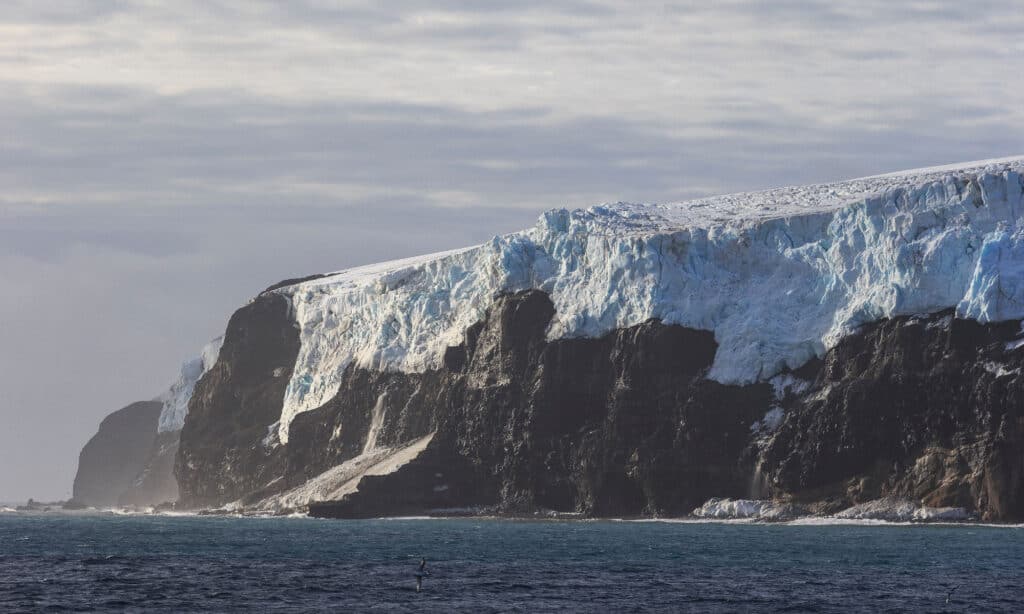
Even though only 7% of Bouvet Island isn’t covered in glaciers, animals use the remaining land as a breeding ground.
©Nodir Tursunzade/Shutterstock.com
While we took a look at 8 islands in the middle of the Atlantic Ocean, there are plenty more. Here are some islands that didn’t quite make the cut, however, are noteworthy islands nonetheless.
- Madiera Island Located in the northern Atlantic, Madeira Island of an autonomous region of Portugal. It was first discovered in the 15th century by Portuguese sailors and became a stop-over locale for Christopher Columbus when journeying to the Americas. Its population is 260,000. Notable animals include the Madeiran wall lizard, Madeira laurel pigeon, Zino’s petrel, Madeira firecrest, and Madeira pipistrelle.
- Bouvet Island This island was discovered in 1739 by a French naval officer but was claimed by Norway as a dependency after an expedition in 1927. This island is uninhabited by humans, but has many animals that call it home: Antarctic fur seals, Antarctic petrels, Weddell seals, Chinstrap penguins, and Emperor penguins.
- Cape Verde Cape Verde is another island colonized by the Portuguese in the 15th century and was used during the Atlantic slave trade given its proximity to the coast of West Africa. With a population of 560,000, this island has 24 cities and 19 towns and is a popular tourist destination. Animals that can be seen there include sperm whales, bats, wood pigeons, and dolphins.
Summary of 8 Islands in the Middle of the Atlantic Ocean
| Index | Island | Population |
|---|---|---|
| 1 | Ascension Island | 800 |
| 2 | Saint Helena | 4,439 |
| 3 | Tristan da Cunha | 245 |
| 4 | Saint Peter and Saint Paul Archipelago | 4 |
| 5 | Trindade and Martim Vaz | 8 |
| 6 | Azores | 236,440 |
| 7 | South Georgia and the South Sandwich Islands | 30 |
| 8 | Bermuda | 63,913 |
The photo featured at the top of this post is © iStock.com/Grant Thomas
Thank you for reading! Have some feedback for us? Contact the AZ Animals editorial team.



